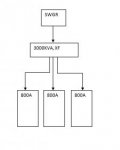I'm looking into installing a Vacuum Circuit Breaker(VCB) on a Switch gear that supplies a 3000KVA transformer, this transformer feeds 3 panels rated 800A in each of 2 500MCM parallel runs( see the attached diagram)
If I want to protect the secondary of the transformers I would need to have to monitor the current going to each panel(3CT's for each panel total 9 CT's), at least this is what I think should be done to protect the cables. my logic, the cables for each panel is rated at 800A and the available current from the XF is 3600A, if I have a fault between the XF and the panel I want to open my VCB when the current exceed the 800A ampacity for the cable.
I'm being told that monitoring the overall current on each phase(3 CT's on the secondary side) will provide the protection needed, how would that work?

If I want to protect the secondary of the transformers I would need to have to monitor the current going to each panel(3CT's for each panel total 9 CT's), at least this is what I think should be done to protect the cables. my logic, the cables for each panel is rated at 800A and the available current from the XF is 3600A, if I have a fault between the XF and the panel I want to open my VCB when the current exceed the 800A ampacity for the cable.
I'm being told that monitoring the overall current on each phase(3 CT's on the secondary side) will provide the protection needed, how would that work?

